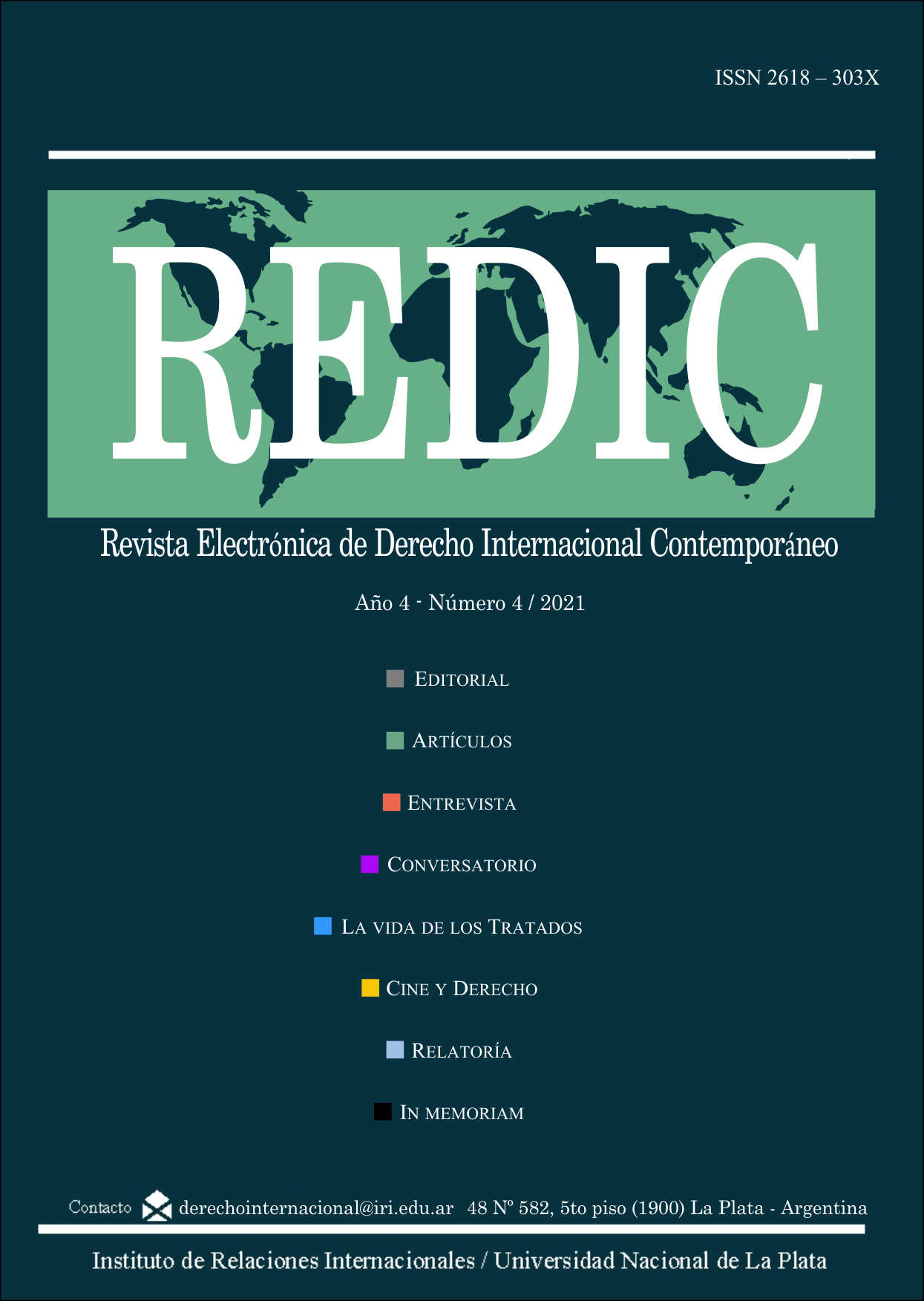A 70 años del Convenio para la represión de la trata de personas y de la explotación de la prostitución ajena: la capacidad de la sociedad civil de impulsar cambios
DOI:
https://doi.org/10.24215/2618303Xe027Palabras clave:
trata de personas, prostitución, feminismo, derecho internacional, derechos humanosResumen
En 1951 entró en vigor el Convenio para la represión de la trata de personas y de la explotación de la prostitución ajena, tratado internacional que por casi cincuenta años fue el documento jurídico clave en la lucha contra la trata de personas. Así, este año se cumplen siete décadas de su entrada en vigor, por lo que este artículo se enfocará en dicho Convenio. La metodología por utilizar será documental, particularmente artículos de revistas académicas arbitradas, capítulos de libros, documentos de organizaciones no gubernamentales bien acreditadas, así como de agencias de las Naciones Unidas, y diversas fuentes de derecho internacional sobre la materia. En cuanto a la estructura, primero se realizará una revisión histórica de cómo el movimiento feminista logró posicionar este tema en la agenda política internacional. Luego se analizará el contenido del Convenio de 1951 y la recepción recibida. Finalmente, se explicarán los nuevos tratados en materia de trata de personas que han surgido con posterioridad al Convenio de 1951 y se elaborarán unas conclusiones al respecto de su efectividad histórica y cómo la creación de estos documentos internacionales ha sido la victoria de una sociedad civil organizada.
Descargas
Citas
Angulo, D. (2020). Trata y otras violencias contra las mujeres. Revista Venezolana de Estudios de la Mujer, 25(54), 11-17.
Asamblea Parlamentaria del Consejo de Europa. (1958). Calling for speedy ratification of the International Convention of 2nd December 1949 for the Suppression of the Traffic in Persons and of the Explotation of Prostitution. http://assembly.coe.int/nw/xml/XRef/Xref-XML2HTML-en.asp?fileid=14198&lang=en
Bassiouni, C., Rothenberg, D., Higonnet, E., Farenga, C. & Invictus, A. (2010). Addressing International Human Trafficking in Women and Children for Commercial Sexual Exploitation in the 21st century. Revue internationale de droit pénal, 81, 417-491. https://doi.org/10.3917/ridp.813.0417
Biblioteca Audiovisual de Derecho Internacional de las Naciones Unidas. (s.f.). Convenio para la represión de la trata de personas y de la explotación de la prostitución ajena de 1950. https://legal.un.org/avl/pdf/ha/uncstpepo/uncstpepo_ph_s.pdf
Capriles, V. (2021). Trata de mujeres venezolanas en el contexto de la crisis migratoria y de refugiados: Respuestas de Colombia, México y Trinidad y Tobago (2017-2020). En Brewer-Carías, A. & Ayala, C. (Coords.), Libro Homenaje al Dr. Pedro Nikken Tomo I. (pp. 419-450). Academia de Ciencias Políticas y Sociales de Venezuela.
Christoplos, I., Funder, M., McGinn, C., & Wairimu, W. (2014). Conclusions: what role for civil society? In human rights perspectives on climate change adaptation: Civil society experiences in Cambodia and Kenya (pp. 51–58). Danish Institute for International Studies.
Chuang, J. (1998). Redirecting the Debate over Trafficking in Women: Definitions, Paradigms, and Contexts. Harvard Human Rights Journal, 11, 65-75.
Convención internacional para la supresión de la trata de mujeres y menores (1921). https://www.senado.gob.mx/comisiones/desarrollo_social/docs/marco/Convencion_ITM.pdf
Convención sobre la eliminación de todas las formas de discriminación contra la mujer de 1979. https://www.ohchr.org/sp/professionalinterest/pages/cedaw.aspx
Corte Interamericana de Derechos Humanos. (2016, 20 de octubre). Sentencia caso trabajadores de la Hacienda Brasil Verde vs. Brasil: Excepciones Preliminares, Fondo, Reparaciones y Costas. http://www.corteidh.or.cr/docs/casos/articulos/seriec_318_esp.pdf
Daich, D. (2012). ¿Abolicionismo o reglamentarismo? Aportes de la antropología feminista para el debate local sobre la prostitución. RUNA XXXIII, (1), 71-84.
Demleitner, N. (1994). Forced Prostitution: Naming an International Offense. Fordham International Law Journal, 18(1), 163-197. https://ir.lawnet.fordham.edu/ilj/vol18/iss1/5
Dunbar, M. (1999). The Past, Present, and Future of International Trafficking in Women for Prostitution, Buffalo Women's Law Journal, 8(17), 103-128. https://digitalcommons.law.buffalo.edu/bwlj/vol8/iss1/17
Farrior, S. (1997). The International Law on Trafficking in Women and Children for Prostitution: Making it Live up to its Potential. Harvard Human Rights Journal, 10, 213-216.
García del Blanco, V. (2019). Lucha contra la trata de personas con finalidad de explotación sexual: la regulación de la prostitución. En M. Cano y A. Muro (Coord.), Algunas reflexiones en torno al pacto mundial por una migración regular, segura y ordenada (pp. 57-76). Dykinson.
García, M. (2012). The League of Nations and the Moral Recruitment of Women. International Review of Social History, 57, 97-128.
George, A., Vindhya, U., & Ray, S. (2010). Sex Trafficking and Sex Work: Definitions, Debates and Dynamics — A Review of Literature. Economic and Political Weekly, 45(17), 64-73.
Gheytanchi, E., y Moghadam, V. N. (2014). Women, Social Protests, And The New Media Activism In The Middle East And North Africa. International Review of Modern Sociology, 40(1), 1–26.
Hauge, C. (1995). Prostitution of Women and International Human Rights Law: Transforming Exploitation into Equality. N.Y. INT'L. L. REv., 8, 23-34.
Hyland, K. (2001). The Impact of the Protocol to Prevent, Suppress and Punish Trafficking in Persons, Especially Women and Children. Human Rights Brief, 8(2), 30-31.
International Agreement for the Suppression of the “White Slave Traffic,” 18 de mayo de 1904, 35 Stat. 1979, 1 L.N.T.S. 83. http://hrlibrary.umn.edu/instree/whiteslavetraffic1904.html
Kempadoo, K., & Doezema, J. (Eds.). (1998). Global Sex Workers: Rights, Resistance, and Redefinition (1st ed.). Routledge. https://doi.org/10.4324/9781315865768
Malekian, F. (2011). Slavery. En Principles of Islamic International Criminal Law, Malekian, F. (ed). Brill | Nijhoff. https://doi.org/10.1163/ej.9789004203969.i-452
Marcovich, M. (2002). Guide de la Convention de l'ONU du 2 décembre 1949: Pour la répression de la traite des êtres humains et de l'exploitation de la prostitution d'autrui. Coalition Against Trafficking in Women. http://www.mercops.org/Vigentes/106.G_Convencion_ONU.pdf
Maus, E. (2021). La prohibición de la esclavitud en H. Ramírez & J. Soberanes (Coord.), El artículo 1° Constitucional: Una teoría de los derechos humanos (pp. 269-310). Universidad Nacional Autónoma de México Instituto de Investigaciones Jurídicas.
Metzger B. (2007) Towards an International Human Rights Regime during the Inter-War Years: The League of Nations’ Combat of Traffic in Women and Children. En Grant K., Levine P., Trentmann F. (Eds.) Beyond sovereignty. Palgrave Macmillan. https://doi.org/10.1057/9780230626522_4
Organización de las Naciones Unidas, Colección de Tratados. (2021). Protocol to Prevent, Suppress and Punish Trafficking in Persons, Especially Women and Children, supplementing the United Nations Convention against Transnational Organized Crime. https://treaties.un.org/pages/ViewDetails.aspx?src=TREATY&mtdsg_no=XVIII-12-a&chapter=18&clang=_en
Organización de las Naciones Unidas, Colección de Tratados. (2021). Convention for the Suppression of the Traffic in Persons and of the Exploitation of the Prostitution of Others. https://treaties.un.org/Pages/ViewDetails.aspx?src=TREATY&mtdsg_no=VII-11-a&chapter=7
Organización de las Naciones Unidas. (2014). First decade of the mandate of the Special Rapporteur on trafficking in persons, especially women and children. https://www.ohchr.org/Documents/Issues/Trafficking/FirsDecadeSRon_%20trafficking.pdf
Organización Internacional para las Migraciones. (2006). Trata de personas: Aspectos básicos.
Paglia, C. (2008). Feminism Past and Present: Ideology, Action, and Reform. Arion: A Journal of Humanities and the Classics, 16(1), 1–18.
Reanda, L. (1991). Prostitution as a human rights question: problems and prospects of United Nations action. Human Rights Quarterly, 13, 202-228.
Riddell, F. (2019). Death in ten minutes: The Forgotten Life of Radical Suffragette Kitty Marion. Hodder & Stoughton. Londres.
Rivas, A. (2010). La trata de personas es la nueva forma de esclavitud en el siglo XXI. En la calle: revista sobre situaciones de riesgo social, Nº. 17, 7-12.
Simm, G. (2004). Negotiating the United Nations Trafficking Protocol: Feminist Debates, The Australian Year Book of International Law Online, 23(1), 135-160. https://doi.org/10.1163/26660229-023-01-900000007
Staff, M. (2009). Recorrido histórico sobre la trata de personas. Programa Andino de Derechos Humanos. https://www.academia.edu/33096297/Recorrido_hist%C3%B3rico_sobre_la_trata_de_personas
Stark, C. y Hudon, E. (2020). Colonization, Homelessness, and the Prostitution and Sex Trafficking of Native Women. National Resource Center on Domestic Violence. https://vawnet.org/sites/default/files/assets/files/2020-02/NRCDV_ColonizationHomelessnessandProstitution-Jan2020.pdf
Swanson, J. (2016). Sexual liberation or violence against women? The debate on the legalization of prostitution and the relationship to human trafficking. New Criminal Law Review: An International and Interdisciplinary Journal, 19(4), 592–639.
Toepfer, S. & Wells, B. (1994). The Worldwide Market for Sex: A Review of International and Regional Legal Prohibitions Regarding Trafficking in Women, 2 Mich. J. Gender & L. 83. https://repository.law.umich.edu/mjgl/vol2/iss1/4
Young, I. (1994). Civil Society and Social Change. Theoria: A Journal of Social and Political Theory, 83/84, 73–94.
Archivos adicionales
Publicado
Cómo citar
Número
Sección
Licencia
Aquellos autores/as que tengan publicaciones con esta revista, aceptan los términos siguientes:
- Los autores/as conservarán sus derechos de autor y garantizarán a la revista el derecho de primera publicación de su obra, el cuál estará simultáneamente sujeto a la Licencia de reconocimiento de Creative Commons (BY-NC-SA) 4.0 que permite a terceros compartir la obra siempre que se indique su autor y su primera publicación esta revista, no se haga uso comercial, y si se remezcla, se transforma o se crea a partir del material, se debe distribuir bajo la misma licencia del original.
- Los autores/as podrán adoptar otros acuerdos de licencia no exclusiva de distribución de la versión de la obra publicada (p. ej.: depositarla en un archivo telemático institucional o publicarla en un volumen monográfico) siempre que se indique la publicación inicial en esta revista.
- Se permite y recomienda a los autores/as difundir su obra a través de Internet (p. ej.: en archivos telemáticos institucionales o en su página web) antes y durante el proceso de envío, lo cual puede producir intercambios interesantes y aumentar las citas de la obra publicada. (Véase El efecto del acceso abierto).































